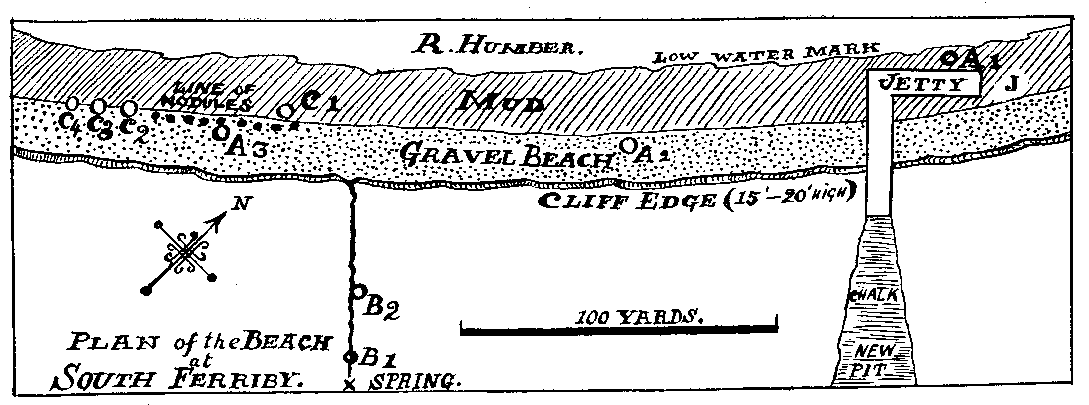TRANSACTIONS
OF THE
HULL
GEOLOG ICAL
SOCIETY
THE CLAYS ON THE FORESHORE AT SOUTH FERRIBY, LINCS.
By W. C. ENNIS, B.Sc.
The
following notes supplement the account given in these Transactions*.
In that article, Mr. T. Sheppard, M.Sc., F.G.S., has shown that Speeton
belemnites were found in quantity on the foreshore. The problem remaining
was to ascertain the stratigraphical position and distribution of the clays
themselves.

The excavation of a new chalk quarry, and the erection of a jetty in 1924,
gave valuable help. In digging for the foundations of the jetty, the red
chalk was well exposed, and a fine junction between the grey and red chalk
was shown at J on the accompanying plan. At the excavation marked A about a
foot of greenish sandy material, corresponding to the Carstone, was found.
This was particularly characteristic, and reminded one very much of the
Carstone near Nettleton Hill. About 3 feet of blue clay was proved under
this, and the clay occurred still lower. No fossils were seen. At A2
only gravelly rubble, filling up the old valley leading from the spring,
occurs. At A3, a trench was dug near the line of exposed septarian nodules.
Blue clay was proved to a depth of 5 feet. Decayed .and quite indeterminate
ammonites and mollusca were obtained, giving a general impression of
Kimmeridge types.
In May, 1925, red chalk was proved at B1, and a
deep hole was made at B2. Here the blue clay was soon reached and carefully
examined. Some small ammonites and crushed shells were found. The ammonites
were identified by Dr. Spath as Rasenia, definitely of Lower
Kimmeridgian age.
In September, 1926, further digging was undertaken. At C1, about 160 feet
from the spring opening in the cliff and among the nodules, about 4 feet of
blue comminuted clay were proved. The fossils found included large
Ostrea, small thin belemnites of
Kimmeridgian type, crushed ammonites, and abundant pecten, or lima, on
masses of pyrites. One fairly good ammonite of Kimmeridgian form was
photographed by Mr. Somerscales. The belemnites were similar to those found
more recently on the beach, and are probably young specimens of B.
abbreviatus (brevi-axis ).
At C2 a large nodule, similar to those exposed on the beach, was found 18
inches below the surface, resting on blue clay.
A hole at C3 proved beach gravel, chalky boulder clay, and finally blue
clay, at a depth of 2½ feet. At C4, a hole 2½ feet deep showed reddish-brown
loamy clay, then chalky boulder clay. The blue clay was not reached.
About 150 belemnite fragments were collected on the beach, chiefly by Mr.
Sheppard. They all occurred within two square yards! None of these resembled
Speeton forms.
The investigations seemed to show :--
(1) That Speeton belemnites have been found on the foreshore, in
quantity, years ago.
(2) That they are not found there now.
(3) That the blue clay is, as general considerations lead one to expect, of
Lower Kimmeridgian age.
(4) That since the red chalk has been proved to lie directly on the Lower
Kimmeridge, any deposit of Speeton Clay in situ is highly improbable.
(5) That the Speeton fossils must have come from the boulder clay, or from
some great mass of Speeton Clay once included in it,** but now washed away
or covered by beach deposits or Humber mud.
We are indebted for a grant from the Geological Society of London, which
assisted us in carrying out this work.
* Vol. VI., Part V. (287-9). 19
** As, for instance, the mass of Speeton Clay resting on the top of the
Chalk, near the lighthouse at Flamborough.--ED.
Copyright Hull Geological Society 2016
